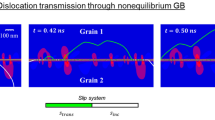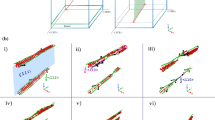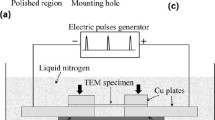Abstract
Annealing-induced microstructural evolution and associated stress relief were investigated experimentally for various crystallographic orientations and annealing temperatures. Combinations of the site and orientation-specific X-ray plus electron diffraction were used. 2-D discrete dislocation dynamics, oriented for double slip with both dislocation glide and climb mechanisms, was employed to simulate the annealing process. Irrespective of crystal orientation, both experiments and simulations showed the highest stress relief at the intermediate annealing temperature. In the experiments, this was related to the fastest elimination of low angle grain boundaries. In the simulations, it was linked to the largest reduction in the density of pinned dislocations. The simulations also suggested that the non-monotonic temperature dependence of the stress relief, and associated substructural changes, emerged from a balance between dislocation glide and climb processes.











Similar content being viewed by others
References
Frederick John Humphreys and Max Hatherly: Recrystallization and related annealing phenomena. second ed. (Pergamon Materials Series, Elsevier, Oxford 2004).
B. Verlinden, J. Driver, I. Samajdar and R.D. Doherty: Thermo-mechanical Processing of Metallic Materials. (Elsevier, Oxford, 2007).
B. Bay, N. Hansen, D. A. Hughes and D. Kuhlmann-Wilsdorf, Acta Metallurgica et Materialia 1992, vol. 40, pp. 205-219.
L.E. Levine, B.C. Larson, W. Yang, M.E. Kassner, J.Z. Tischler, M.A. Delos-Reyes, R.J. Fields, W. Liu, Nat. Mater. 2006, vol. 5, pp. 619-622.
H. Mughrabi, Acta Metallurgica 1983, vol. 31, pp. 1367-1379.
A. Lodh, T.N. Tak, A. Prakash, P.J. Guruprasad, C. Hutchinson, I. Samajdar, Metall. Mater. Trans. A 2017, vol. 48, pp. 5317-5331
Q Xing, X Huang and N Hansen, Metallurgical and materials transactions A 2006, vol. 37, pp. 1311-1322.
E. Nes, Acta Metallurgica et Materialia 1995, vol. 43, pp. 2189-2207.
D. Raabe: in Physical Metallurgy (Fifth Edition), K. Hono, ed., Elsevier, Oxford, 2014, pp. 2291–2397.
D. Kohli, R. Rakesh, V. P. Sinha, G. J. Prasad and I. Samajdar, Journal of Nuclear Materials 2014, vol. 447, pp. 150-159.
M. Verdier, F. Bley, M. Janecek, F. Livet, J. P. Simon and Y. Bréchet, Materials Science and Engineering: A 1997, vol. 234-236, pp. 258-262.
P. J. Withers and H. K. D. H. Bhadeshia, Materials Science and Technology 2001, vol. 17, pp. 366-375.
M.B. Bever, D.L. Holt, A. L. Titchener, Prog. Mater Sci. 1973, vol. 17, pp. 5-177.
M Verdier, I Groma, L Flandin, J Lendvai, Y Bréchet and P Guyot, Scripta Materialia 1997, vol. 37, pp. 449-454.
M. Verdier, M. Janecek, Y. Bréchet and P. Guyot, Materials Science and Engineering: A 1998, vol. 248, pp. 187-197.
M. B Prime, M. R Hill, Scripta Mater. 2002, vol. 46, pp. 77-82.
M. Verdier, Y. Brechet and P. Guyot, Acta Materialia 1998, vol. 47, pp. 127-134.
SK Shekhawat, V Basavaraj, VD Hiwarkar, R Chakrabarty, J Nemade, PJ Guruprasad, KG Suresh, RD Doherty and I Samajdar, Metallurgical and Materials Transactions A 2014, vol. 45, pp. 3695-3698.
K Wierzbanowski, A Baczmański, R Wawszczak, J Tarasiuk, Ph Gerber, B Bacroix and A Lodini, Materials science and technology 2005, vol. 21, pp. 46-52.
G. Kumar, R. Singh, J. Singh, D. Srivastava, G. K. Dey and I. Samajdar, J. Nucl. Mater. 2015, vol. 466, pp. 243-252.
AA Ridha and WB Hutchinson, Acta metallurgica 1982, vol. 30, pp. 1929-1939.
AA Benzerga, Y Bréchet, A Needleman and E Van der Giessen, Modelling and Simulation in Materials Science and Engineering 2003, vol. 12, p. 159.
V.V Bulatov, L.L Hsiung, M. Tang, A. Arsenlis, M.C Bartelt, W. Cai, J.N. Florando, M. Hiratani, M. Rhee and G. Hommes, Nature 2006, vol. 440, p. 1174.
H. Fan, S. Aubry, A. Arsenlis, J. A. El-Awady, Acta Mater. 2015, vol. 92, pp. 126-139.
Richard LeSar, Annu. Rev. Condens. Matter Phys. 2014, vol. 5, pp. 375-407.
AA Benzerga, Y Brechet, A Needleman and E Van der Giessen, Acta Mater. 2005, vol. 53, pp. 4765-4779.
Lucia Nicola, Erik Van der Giessen and Alan Needleman, J. Appl. Phys. 2003, vol. 93, pp. 5920-5928.
D. Kiener, PJ Guruprasad, SM Keralavarma, G. Dehm and AA Benzerga, Acta Materialia 2011, vol. 59, pp. 3825-3840.
M.D. Uchic, P.A. Shade, D.M. Dimiduk, Annu Rev Mater. Res. 2009, vol. 39, pp. 361-386.
J.A. El-Awady, Nat. Commun. 2015, vol. 6, p. 5926.
AA Benzerga, Int. J. Plast. 2008, vol. 24, pp. 1128-1157.
S Akarapu, HM Zbib and DF Bahr, Int. J. Plast. 2010, vol. 26, pp. 239-257.
K.M. Davoudi, L. Nicola and J.J. Vlassak, J. Appl. Phys. 2012, vol. 111, p. 103522.
SM Keralavarma, T. Cagin, A. Arsenlis and AA Benzerga, Physical Review Letters 2012, vol. 109, p. 265504.
Dan Mordehai, Emmanuel Clouet, Marc Fivel and Marc Verdier, Philosophical Magazine 2008, vol. 88, pp. 899-925.
Kostas Danas and VS Deshpande, Modell. Simul. Mater. Sci. Eng. 2013, vol. 21, p. 045008.
SM Keralavarma and AA Benzerga, J. Mech. Phys. Solids 2015, vol. 82, pp. 1-22.
SMH Haghighat, G Eggeler and D Raabe, Acta Mater. 2013, vol. 61, pp. 3709-3723.
M. Hiratani, H.M. Zbib and M.A. Khaleel, Int. J. Plast. 2003, vol. 19, pp. 1271-1296.
S.S Shishvan, R.M. McMeeking, T.M. Pollock and V.S Deshpande, Acta Mater. 2017, vol. 135, pp. 188-200.
G. Kumar, A. Lodh, J. Singh, R. Singh, D Srivastava, GK Dey and I Samajdar, CIRP J. Manuf. Sci. Technol. 2017, vol. 19, pp. 176-190.
G. Kumar, S. Balo, A. Dhoble, J. Singh, R. Singh, D. Srivastava, G.K. Dey and I. Samajdar, Metall. Mater. Trans. A 2017, vol. 48, pp. 2844-2857.
S Raveendra, H Paranjape, S Mishra, H Weiland, RD Doherty and I Samajdar, Metallurgical and Materials Transactions A 2009, vol. 40, pp. 2220-2230.
M.H. Alvi, S. W. Cheong, J. P. Suni, H. Weiland and A. D. Rollett, Acta Mater. 2008, vol. 56, pp. 3098-3108.
DP Field, PB Trivedi, SI Wright and M Kumar, Ultramicroscopy 2005, vol. 103, pp. 33-39.
Fabrice Barou, Claire Maurice, Jean-Marie Feppon and Julian Driver, International Journal of Materials Research 2009, vol. 100, pp. 516-521.
S Ghosh, M Li and D Gardiner, Journal of manufacturing science and engineering 2004, vol. 126, pp. 74-82.
SK Shekhawat, R Chakrabarty, V Basavaraj, VD Hiwarkar, KV Mani, PJ Guruprasad, AA Benzerga, KG Suresh and I Samajdar, Acta Materialia 2015, vol. 84, pp. 256-264.
S Groh, EB Marin, MF Horstemeyer and HM Zbib, International Journal of Plasticity 2009, vol. 25, pp. 1456-1473.
PJ Guruprasad and AA Benzerga, Journal of the Mechanics and Physics of Solids 2008, vol. 56, pp. 132-156.
PJ Guruprasad, WJ Carter and AA Benzerga, Acta Materialia 2008, vol. 56, pp. 5477-5491.
S. Raveendra, S. Mishra, K.V. M. Krishna, H. Weiland and I. Samajdar, Metall. Mater. Trans. A 2008, vol. 39, p. 2760.
BD Cullity: Elements of X-Ray Diffraction. 2nd Edition, Adisson-Wesley Publishing, Phillippines. 1978.
I.C. Noyan and J.B. Cohen: Residual Stress: Measurement by Diffraction and Interpretation. Springer, New York (2013)
Jérémy Epp, Holger Surm, Thomas Hirsch and Franz Hoffmann, Journal of Materials Processing Technology 2011, vol. 211, pp. 637-643.
H. Hu: in Recovery and Recrystallization of Metals, L. Himmel (ed.), Wiley, New York, 1963, pp 311–78
JS Kallend and YC Huang, Metal science 1984, vol. 18, pp. 381-386.
David D Sam and Brent L Adams, Metallurgical and Materials Transactions A 1986, vol. 17, pp. 513-517.
N Rajmohan and JA Szpunar, Acta Mater. 2000, vol. 48, pp. 3327-3340.
I. Samajdar and R.D. Doherty, Scripta Metall. Mater. 1995, vol. 32, pp. 845–850.
Indradev Samajdar, Petar Ratchev, Bert Verlinden and Etienne Aernoudt, Acta Mater. 2001, vol. 49, pp. 1759-1769.
Niels Hansen, Xiaoxu Huang, Wolfgang Pantleon and Grethe Winther, Philosophical Magazine 2006, vol. 86, pp. 3981-3994.
X. Feaugas and H. Haddou, Philos. Mag. 2007, vol. 87, pp. 989–1018.
R Khatirkar, LAI Kestens, R Petrov, P Pant and I Samajdar, ISIJ Int. 2011, vol. 51, pp. 849-856.
A. Lodh, U. Tewary, R.P. Singh, T.N. Tak, A. Prakash, A. Alankar, P.J. Guruprasad and I. Samajdar, Metall. Mater. Trans. A, 2018.
IL Dillamore, JG Roberts and AC Bush, Metal Science 1979, vol. 13, pp. 73-77.
R Khatirkar, LAI Kestens, R Petrov and I Samajdar, ISIJ Int. 2009, vol. 49, pp. 78-85.
A Korbel, JD Embury, M Hatherly, PL Martin and HW Erbsloh, Acta Metallurgica 1986, vol. 34, pp. 1999-2009.
R Khatirkar, B Vadavadagi, SK Shekhawat, A Haldar and I Samajdar, ISIJ Int. 2012, vol. 52, pp. 884-893
A Albou, A Borbely, C Maurice and JH Driver, Philos Mag 2011, vol. 91, pp. 3981-4000.
BB He: Two-Dimensional X-Ray Diffraction. Wiley, New York, 2011.
Acknowledgments
AL, PJG, and IS would like to acknowledge financial support from DST-SERB (India). Support from IITB-Monash research academy and National Facility of Texture and OIM (IITB) is also appreciated. AAB gratefully acknowledges support from the Lawrence Livermore National Laboratory under Master Task Agreements No. B599687 and B602391.
Author information
Authors and Affiliations
Corresponding author
Additional information
Publisher's Note
Springer Nature remains neutral with regard to jurisdictional claims in published maps and institutional affiliations.
Manuscript submitted December 12, 2018.
Appendix
Appendix
A typical texture measurement scheme with 10 deg step size in tilt (ψ) and rotation (φ) is shown in Figure A1(a). By rotation and tilt, we achieved the different measurement points, shown as circles in the scheme. X-ray diffraction from a polycrystalline material captured by an area detector appeared as ring(s), shown in γ − 2θ coordinates in Figure A1(b). For any particular combination of (ψ, φ, γ, θ, ω), the part of the diffraction ring was converted to the pole figure angles (α, β) as following[71]
(a) A standard pole figure measurement scheme with 10 deg step in rotation (ϕ) and tilt (ψ) angle. (b) The γ integration of a diffraction ring for (111) pole. It shows which points in the pole figure were getting calculated for a particular γ range. (c) Multiple polar angles corresponding to a single-pole figure position, which appeared to be an ambiguity of numerical solution. Such values were averaged out
where h1, h2, and h3 are the unit vector components along the sample coordinates,
Different segments of the diffraction ring (based on γ spread and 2θ) captured different measurement points of the texture scheme as shown in Figure A1(b). In this study, we followed this procedure to obtain all possible measurement points (with 10 deg step size). For all of these points, residual stress was calculated from peak shift considering d0 as the equilibrium lattice spacing at strain-free state (obtained from annealed powder specimen). It is to be noted that this numerical scheme gave rise to multiple combinations of solutions corresponding to a single point in the texture measurement scheme (see Figure A1(c)). For such cases, the values were averaged out.
Rights and permissions
About this article
Cite this article
Lodh, A., Tak, T.N., Prakash, A. et al. Microstructural Origin of Residual Stress Relief in Aluminum. Metall Mater Trans A 50, 5038–5055 (2019). https://doi.org/10.1007/s11661-019-05421-8
Received:
Published:
Issue Date:
DOI: https://doi.org/10.1007/s11661-019-05421-8





